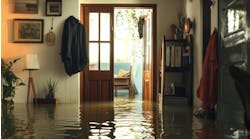Latest from Management
Show Customers All the Ways They Can Buy
Sponsored
Fishing and hunting clubs in remote locations where no electricity is available can present unique challenges for adding creature comforts. Maintaining the rustic appeal desired by their members is often a high priority. A huge snowfall caused the collapse of an old 1800s-era log cabin a few decades ago and in its place a new log cabin had been constructed by the members of the club.
Indoor plumbing was reinstalled with water lines slopped to facilitate winterization. Water is delivered from a natural spring on the hill behind and above the cabin. It’s covered with an enclosed stone-and-mortar spring house to (in theory) help keep the water clean. Frogs, snakes and assorted bugs can normally be found in residence! A stainless steel well-water foot-valve screen threaded onto a 1-in. nylon barbed adaptor keeps the critters from being sucked into the plastic well piping that trails down the hillside to the cabin. The water pressure at the cabin is just over 29-PSI. At 2.31 feet per pound, that places the inlet of the pipe 67.5 feet above the cabin.
Over the years, the members have had indoor-rated propane lights installed that are adjustable (brightness per each lamp approaches 100-Watts when turned up to maximum fire), and an infrared vent-free heater with self-regulating thermostat that provides indoor comfort on even the coldest days of the year. One element preserved from the original cabin — the one part that did not collapse — is a huge stone fireplace. More than a decade ago, it was suggested we install an outdoor shower and one of the members provided a propane-fired, RV-style five gallon water heater, which was mounted on the cabin’s exterior wall. Its limited capacity required short showering or interrupted get-wet/turn-off/soap-up/rinse-off bathing and generated more than a few complaints!
They wanted more hot water! Without electricity, the options were fairly limited. Placing a tank-style water heater outdoors was not an option unless housed in its own structure and the club members nixed that idea. The search led to an unexpected surprise: a tankless water heater, the Bosch AquaStar model 1600H with this opening statement in the literature, “Who said water can’t light a fire? The Bosch AquaStar Model 1600H incorporates a revolutionary hydro-generated ignition system, allowing the water heater to operate without a standing pilot, electricity or a battery. This innovative technology uses the energy from the flowing water to ignite the spark. The Bosch AquaStar Model 1600H is the first tankless water heater of this kind.”
Three issues loomed large: the Bosch literature listed a minimum inlet pressure of 30-PSI; the 1600H was not rated for an outdoor installation; and the low water pressure would prevent the use of any water-treatment filtration. The outdoor issue would require building an enclosure, but the pressure issue could turn into an expensive failure, and, the lack of spring-water treatment could lead to scaling within the tankless heat exchanger. In spite of the risks, the club approved its installation.
The exterior tankless house was constructed to be attached to the cabin’s exterior wall with its bottom screened to provide an adequate combustion-air intake, which also prevents critters from setting up housekeeping. The top was ventilated using round aluminum soffit louvers to avoid heat build-up within the enclosure and B-vent was installed and braced away from the wooden cabin walls to avoid any potential for fire.
Three … two … one …. Fire! As water rushed through the Bosch 1600H for the first time, the control panel lights flickered on, the spark-igniter sizzled, and the burner came to life! The hydro-generator in the cold-water inlet piping could be faintly heard whirring away while creating close to 2-volts DC (direct current), which is utilized by the control panel to generate the ignition and modulate the gas valve. The hillside gravity flow provides a bit more than 2 GPM from the showerhead and with a 55°F cold-water inlet temperature, the tankless was able to deliver a steady-stream of 147°F hot water! The front of the enclosure provides two adjustment knobs for regulating water-flow and adjusting outlet temperature. Dialed back to 120°F for better thermal safety, the club members enjoy endless hot water while using a tankless water heater where no external source of electricity is available. The outdoor shower is very popular and cabin usage increased dramatically. Each year the push is on by club members to put off winterization as long as possible. Deer season finds hunters settling into the cabin for the duration. It’s a game of cat-and-mouse with Mother Nature that requires a rapid response if a sudden change brings freezing weather and resulted in one replacement over the past eight years.
Winterizing the Bosch 1600H is relatively easy by pulling a few clips that retain the inlet filter, piping to the heat exchanger, and that amazing little hydro-generator, which are removed and stored for safe keeping until spring. An inverter connected to the truck’s battery provides 115-volt power for a tankless flush-kit and annual cleaning to ensure the heat exchanger remains scale-free.
All Dave Yates material in print and on Contractor's Website is protected by Copyright 2012. Any reuse of this material (print or electronic) must first have the expressed written permission of Dave Yates and Contractor magazine. Please contact via email at: [email protected].
Dave Yates
Dave Yates material in print and on Contractor’s Website is protected by Copyright 2017. Any reuse of this material (print or electronic) must first have the expressed written permission of Dave Yates and Contractor magazine.

